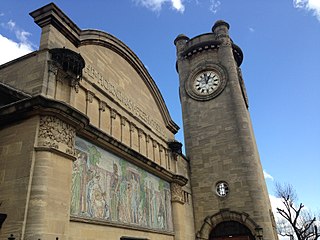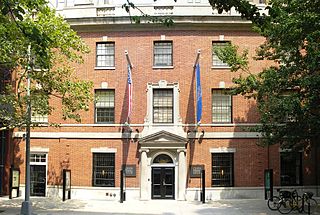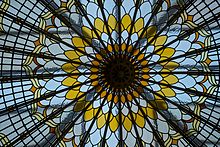
The Worshipful Company of Drapers is one of the 111 livery companies of the City of London. It has the formal name The Master and Wardens and Brethren and Sisters of the Guild or Fraternity of the Blessed Mary the Virgin of the Mystery of Drapers of the City of London. More usually known simply as the Drapers' Company, it is one of the historic Great Twelve Livery Companies and was founded during the Middle Ages.

Bishopsgate was one of the eastern gates in London's former defensive wall. The gate's name is traditionally attributed to Earconwald, who was Bishop of London in the 7th century. It was first built in Roman times and marked the beginning of Ermine Street, the ancient road running from London to York (Eboracum). The gate was rebuilt twice in the 15th and 18th centuries, but was permanently demolished in 1760.

Edward "Ned" Alleyn was an English actor who was a major figure of the Elizabethan theatre and founder of the College of God's Gift in Dulwich.

The Horniman Museum and Gardens is a museum in Forest Hill, London, England. Commissioned in 1898, it opened in 1901 and was designed by Charles Harrison Townsend in the Modern Style. It has displays of anthropology, natural history and musical instruments, and is known for its large collection of taxidermied animals. The building is Grade II* listed.

The Wellcome Trust is a charitable foundation focused on health research based in London, in the United Kingdom. It was established in 1936 with legacies from the pharmaceutical magnate Henry Wellcome to fund research to improve human and animal health. The aim of the Trust is to "support science to solve the urgent health challenges facing everyone." It had a financial endowment of £29.1 billion in 2020, making it the fourth wealthiest charitable foundation in the world. In 2012, the Wellcome Trust was described by the Financial Times as the United Kingdom's largest provider of non-governmental funding for scientific research, and one of the largest providers in the world. According to their annual report, the Wellcome Trust spent GBP £1.1Bn on charitable activities across their 2019/2020 financial year. According to the OECD, the Wellcome Trust's financing for 2019 development increased by 22% to US$327 million.

George Jacob Holyoake was an English secularist, co-operator and newspaper editor. He coined the terms secularism in 1851 and "jingoism" in 1878. He edited a secularist paper, the Reasoner, from 1846 to June 1861, and a co-operative one, The English Leader, in 1864–1867.

Bishopsgate Library, now known as Bishopgate Institute's Special Collections and Archives is an independent, charity-funded library located within the Bishopsgate Institute in the City of London.

The Royal Anthropological Institute of Great Britain and Ireland (RAI) is a long-established anthropological organisation, and Learned Society, with a global membership. Its remit includes all the component fields of anthropology, such as biological anthropology, evolutionary anthropology, social anthropology, cultural anthropology, visual anthropology and medical anthropology, as well as sub-specialisms within these, and interests shared with neighbouring disciplines such as human genetics, archaeology and linguistics. It seeks to combine a tradition of scholarship with services to anthropologists, including students.

The College of God's Gift, often referred to as the Old (Dulwich) College, was a historic charity founded in 1619 by the Elizabethan actor and businessman Edward Alleyn who endowed it with the ancient Manor of Dulwich in south London. In 1857 it was renamed as Alleyn's College of God's Gift. The charity was reorganised in 1882 and again in 1995, when its varied component activities were split up into separate registered charities. The former constituent elements of College of God's Gift, which have been independent charities since 1995, are:

St Botolph's Aldgate is a Church of England parish church in the City of London and also, as it lies outside the line of the city's former eastern walls, a part of the East End of London. The church served the ancient parish of St Botolph without Aldgate which included the extramural Portsoken Ward of the City of London, as well as East Smithfield which is outside the City.

The Working Class Movement Library (WCML) is a collection of English language books, periodicals, pamphlets, archives and artefacts, relating to the development of the political and cultural institutions of the working class created by the Industrial Revolution, in Salford, Greater Manchester, England.

St Botolph-without-Bishopsgate is a Church of England church in the Bishopsgate Without area of the City of London, and also, by virtue of lying outside the city's eastern walls, part of London's East End.

The Center for Jewish History is a partnership of five Jewish history, scholarship, and art organizations in New York City: American Jewish Historical Society, American Sephardi Federation, Leo Baeck Institute New York, Yeshiva University Museum, and YIVO Institute for Jewish Research. Together, housed in one location, the partners have separate governing bodies and finances, but collocate resources. The partners' collections make up the biggest repository of Jewish history in the United States. The Center for Jewish History also serves as a centralized place of scholarly research, events, exhibitions, and performances. Located within the center are the Lillian Goldman Reading Room, Ackman & Ziff Family Genealogy Institute and a Collection Management & Conservation Wing. The Center for Jewish History is also an affiliate of the Smithsonian Institution.
The Borthwick Institute for Archives is the specialist archive service of the University of York, York, England. It is one of the biggest archive repositories outside London. The Borthwick was founded in 1953 as The Borthwick Institute of Historical Research. It was originally based at St Anthony's Hall, a fifteenth-century guild hall on Peasholme Green, in central York. Since 2005 it has been based in a purpose-built building, situated adjacent to the JB Morrell Library on the University of York's Heslington West campus. This new building was made possible due to a grant of £4.4 million by the Heritage Lottery Fund and designed by Leach Rhodes Walker and Buro Happold.
Charles Harrison Townsend was an English architect. He was born in Birkenhead, educated at Birkenhead School and articled to the Liverpool architect Walter Scott in 1870. He moved to London with his family in 1880 and entered partnership with the London architect Thomas Lewis Banks in 1884. Townsend became a member of the Art Workers' Guild in 1888 and in the same year was elected a Fellow of the more conservative Royal Institute of British Architects. He remained an active member of both organisations throughout his career and was elected Master of the Art Workers' Guild in 1903. He is important Modern Style architect whose favourite motif was the tree.

Crosby Hall is a historic building in London. The Great Hall was built in 1466 and originally known as Crosby Place in Bishopsgate, in the City of London. It was moved in 1910 to its present site in Cheyne Walk, Chelsea. It now forms part of a private residence, which in 2021 was renamed Crosby Moran Hall.
Charles William Frederick Goss (1864–1946) was an English librarian, polemicist and cataloguing innovator. He worked in English public libraries at the turn of, and the early, twentieth century, and was prominent among opponents of open access libraries in the UK.

The London and Middlesex Archaeological Society (LAMAS) is a society founded in 1855 for the study of the archaeology and local history of the City of London and the historic county of Middlesex. It also takes an interest in districts that were historically in Surrey, Kent, Essex and Hertfordshire, but that now lie within Greater London. The Society receives support from the Museum of London, and works in close association both with the Museum and with Museum of London Archaeology. It acts to some extent as an umbrella organisation to support smaller archaeological and local history societies in the Greater London area. It hosts an Annual Conference of London Archaeologists and an annual Local History Conference.

Museum of Freemasonry, based at Freemasons’ Hall, London, is a fully accredited museum since 2009, with a designated outstanding collection of national importance since 2007 and registered charitable trust since 1996. The facility encompasses a museum, library, and archive.
David Titterington is a British organist, educator and artistic director.

















